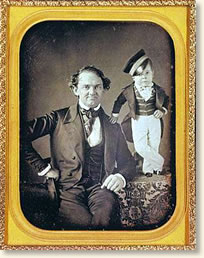|
P.T. Barnum Discovers "Tom Thumb," 1842
He was the greatest showman of his era and possibly of all time. Born in 1810, P.T. Barnum revealed his extraordinary talent as a salesman at an early age. Barnum began his show business career in 1835 when he paid a woman who claimed to be the one-hundred-sixty-one-year-old nurse of George Washington $1,000 for the right to exhibit her in a tour through New York and New England. His investment returned over $1,500 per week and allowed the showman to purchase a building on Broadway in New York City as a permanent venue for exhibiting what he described as “500,000 natural and artificial curiosities from every corner of the world.”
In 1842 Barnum discovered one of his most famous and profitable attractions, a diminutive child of five from Bridgeport, Connecticut named Charles Stratton. Barnum successfully persuaded the boy’s mother to allow him to exhibit her son and brought him to New York. Barnum declared his attraction as being eleven year’s old and gave him the name “Tom Thumb.”
Barnum wrote of his discovery of Tom Thumb in his autobiography:
"I had heard of a remarkably small child in Bridgeport; and by my request my brother brought him to the hotel. He was the smallest child I ever saw that could walk alone. He was not two feet in height, and weighed less than sixteen pounds. He was a bright-eyed little fellow, with light hair and ruddy cheeks, was perfectly healthy, and as symmetrical as an Apollo. He was exceedingly bashful, but after some coaxing he was induced to converse with me, and he told me that he was the son of Sherwood E. Stratton, and that his own name was Charles S. Stratton. After seeing him and talking with him, I at once determined to secure his serŽvices from his parents and to exhibit him in public.
 |
P.T. Barnum and Tom Thumb
ca 1848
|
He was only five years old, and to exhibit a dwarf of that age might provoke the question, 'How do you know that he is a dwarf?' Some license might indeed be taken with the facts, but even with this advantage I really felt that the adventure was nothing more than an experiment, and I engaged him for the short term of four weeks at three dollars per week, all charges, including traveling and boarding of himself and mother, being at my expense.
They arrived in New York on Thanksgiving Day, December 8, 1842, and Mrs. Stratton was greatly astonished to find her son heralded in my Museum bills as GENERAL TOM THUMB, a dwarf of eleven years of age, just arrived from England!
This announcement contained two deceptions. I shall not attempt to justify them, but may be allowed to plead the circumstances in extenuation. The boy was undoubtedly a dwarf, and I had the most reliable evidence that he had grown little, if any, since he was six months old; but had I announced him as only five years of age, it would have been impossible to excite the interest or awaken the curiosity of the public. The thing I aimed at was, to assure them that he was really a dwarf - and in this, at least, they were not deceived.
It was of no consequence, in reality, where he was born or where he came from, and if the announcement that he was a foreigner answered my purpose, the people had only themselves to blame if they did not get their money's worth when they visited the exhibition. I had observed. . . the American fancy for European exotics; and if the deception . . . has done anything toward checking our disgraceful preference for foreigners, I may readily be pardoned for the offense I here acknowledge.
References:
This eyewitness account appears in: Barnum, P.T. Struggles and Triumphs (1884, republished 2009);
How To Cite This Article:
"P.T. Barnum Discovers 'Tom Thumb,' 1842", EyeWitness to History, www.eyewitnesstohistory.com (2011).
|






